
All Solutions

Explore all the solutions you can create with Paperform: surveys, quizzes, tests, payment forms, scheduling forms, and a whole lot more.
See all solutions











Connect with over 2,000 popular apps and software to improve productivity and automate workflows
See all integrationsProducts
Solutions
All Solutions

Explore all the solutions you can create with Paperform: surveys, quizzes, tests, payment forms, scheduling forms, and a whole lot more.
See all solutionsIntegrations

Connect with over 2,000 popular apps and software to improve productivity and automate workflows
See all integrationsResources
How to Build Brand Loyalty with a Customer Rewards Program

Loyal customers are the dream for any business, ecommerce or otherwise. More repeat customers means more sales—and more sales means guaranteed financial stability.
But how do you build customer loyalty? Well, a great way to do so is by creating a customer rewards program to incentivise customers to use your products and services.
By setting up a rewards program you don’t just get a single sale. You encourage people to return to your company again and again and again, to earn points, achieve rewards and get more value over time.
Sound good? In this post we’ll share how you can start a loyalty rewards program of your own to build a strong customer base and start creating loyal customers today.
What is a customer loyalty program?
A customer loyalty program gives people an incentive to become repeat customers of your business by rewarding them for each purchase or engagement with your brand.
The best example of rewards programs is your classic cafe rewards card. You get a card, and every ten or so coffees you buy, you get one for free. The reward (free coffee) incentivises you to become a loyal customer of the business (your local cafe.)
Turning customers into repeat customers is what loyalty programs are all about. By rewarding engagement you encourage customers to do more of it.
Loyal customers tend to make more purchases over time, and become word-of-mouth evangelists of your brand, who promote your business to family and friends.
Think of customer rewards programs like a video game, except customers don’t level up by doing missions—they level up by buying stuff. The more they buy ➡ the higher they rise through the ranks ➡ the more benefits they get.
Exactly what those benefits are depends on your company. It could include just about anything, from perks, cash back deals and freebies to exclusive access to features and services, or even unique products and merchandise.
Why you need a customer rewards program?
Things would be a little one-sided if loyalty programs only benefited customers. Alongside perks they give your members, they offer a bunch of benefits to make it worthwhile for your business.
Boost customer acquisition
Loyal customers are your most valuable assets. Not only do your best customers pay for your products over time, they spread the word about your brand with the people in their personal networks.
"A report by GetVolP found that a good customer experience makes customers 5x more likely to recommend your company or product to their friends or family."
Consumer reviews are gold for your business. 81% of people trust recommendations from family or friends over sponsored ads. That makes these kinds of referrals a great way to promote loyalty and grow your business organically.
Increase sales
As a general rule, we all prefer to use products and brands we know and love. That counts for everything from the type of milk you buy to the brand of toilet paper you use.
Repeat customers are your most dedicated audience. They shop with you again and again, are easier to sell to, tend to spend more on each purchase, during key times of year (ie. Christmas or Black Friday), and increase their spending over time.
Studies have shown that for most companies, up to 65% of business comes from pre-existing customers. Loyal customers are very important.
So how do you encourage your target audience to make repeat purchases? A lot of it comes down to having a great product, a strong brand identity, and years of building trust. But you can speed this up a bit with a customer rewards program.
By incentivising actions—whether it be purchasing or interacting with your brand— you are able to build customer loyalty faster. Just ask any parent about the power of rewards for encouraging desirable behaviours. It works.
Keep your business stable
Small business owners and entrepreneurs constantly worry about converting new leads into customers to boost sales. But if your business won’t stay afloat for long if you only rely on one-time purchases.
"Every brand needs a loyal customer base to keep the lights on. And that’s what a loyalty program helps you build."
With a dedicated customer base, you can worry less about hitting sales targets and focus more on improving your products or services. Acquiring new customers then becomes a secondary aim, rather than your raison d’etre.
Reduce marketing costs
It takes a lot of time and cash to acquire a customer. You can calculate exactly how much by taking the entire cost of sales and marketing over a period—including salaries— and dividing it by the number of new customers you got.
The costs add up. On top of that, there are no guarantees you’ll convert customers, and those you do convert unfortunately don’t come with a special guarantee they’ll stick around.
A customer rewards program gives them something to stick around for. It’s a carrot at the end of the stick that helps you hang on to the customers you already have. It not only leads to improved loyalty, it also increases the lifetime value of customers*.*
With a strong customer base you’ll spend less time chasing leads and more time building a product your existing members love. Plus, they’ll even look after some marketing with you via word of mouth referrals.
How to start a customer rewards program
So we’ve covered what a customer loyalty program is and why you should use one. Now it’s time to guide you through the step-by-step process.
1. Choose your loyalty rewards
The success of your customer rewards program will depend on the incentives you offer. Will it be discounts? Freebies? Coupons to local businesses? New products?
Whatever you choose, make sure it makes sense for your business. For example, it would make no sense for Paperform to give out makeup to loyalty members. It has nothing to do with the business.
But it makes perfect sense for Sephora. Their “Beauty Insiders” can use their points to get first access to products, and participate in exclusive events, sweepstakes and even win meet and greets with celebrity influencers.
 (Image Source: Sephora)
(Image Source: Sephora)Sephora does a great job of understanding their audience. They know the kind of people who make up their customer base and give them relevant perks that match their interests and bring value to their lives.
"It’s about extending the experience beyond the purchase. Think about ways you can do a similar thing with your offering."
For example, a SaaS business might give early access to features or exclusive swag, but a yoga studio might offer a free mat or one on one sessions.
Remember to keep rewards relevant, achievable and scalable. You don’t want to promise something you can’t follow through with and all going well these will scale to thousands of people as you grow.
2. Decide which actions you’ll reward
The right rewards encourage good behaviours. Any dog owner will tell you the same thing. Want to teach a dog to sit? Give it a treat every time it does.
Unfortunately dog treats won’t quite work for your business. But you can encourage favourable behaviours — like repeat purchases — by rewarding customers every time they do something you want them to.
Some of the main actions you should reward include:
- Making a purchase above a specified amount
- Purchasing specific product
- Word-of-mouth referrals
- Posting content on social media
- Buying from your store during a certain period
Will it be simply buying a product like Starbucks’ loyalty card promotes? Or a more nuanced action like interacting with your brand on social media? Just make sure it’s an action that helps you, while offering value to your customers.
3. Settle on a rewards system
Now it’s time to figure out what kind of rewards system you will choose. There are a few main types of programs that offer unique ways to reward customers based on the kind of business you run and what your goals are.
Most companies adhere to a specific type of program. There are a six main ones:
- Points programs. Every time a customer makes a purchase they get a certain amount of redeemable points based on how much money they spent.
- **Paid programs.** Customers are invited to pay a fee and join a VIP member’s club that offers exclusive members-only rewards.
- **Tiered programs.** A gamified system where rewards are split into levels with each one offering better rewards.
- **Progress programs.** These (usually app-based programs) reward users with badges and positive feedback after milestones to link “success” to your brand.
- **Community programs.** A combination points and tiered program that fosters a community of like-minded members to share ideas and meet in real-life events.
- Subscription programs. Subscription services incentivise on-going payments over a one-off purchase by offering ease, convenience and loyalty rewards.
- Partner programs. Partnering with local restaurants, retailers, grocery stores or other stores to increase your presence in the community and benefit your customers in unique ways.
Look for an option that makes sense for your business. A loyalty program should be a holistic part of your offering that sits next to the products and services you offer, not something shoehorned in that doesn't make sense.
Take Nike for example. They’re a sport and fitness brand, so they use a progress program to reward users with badges and other rewards every time they reach a new fitness milestone.
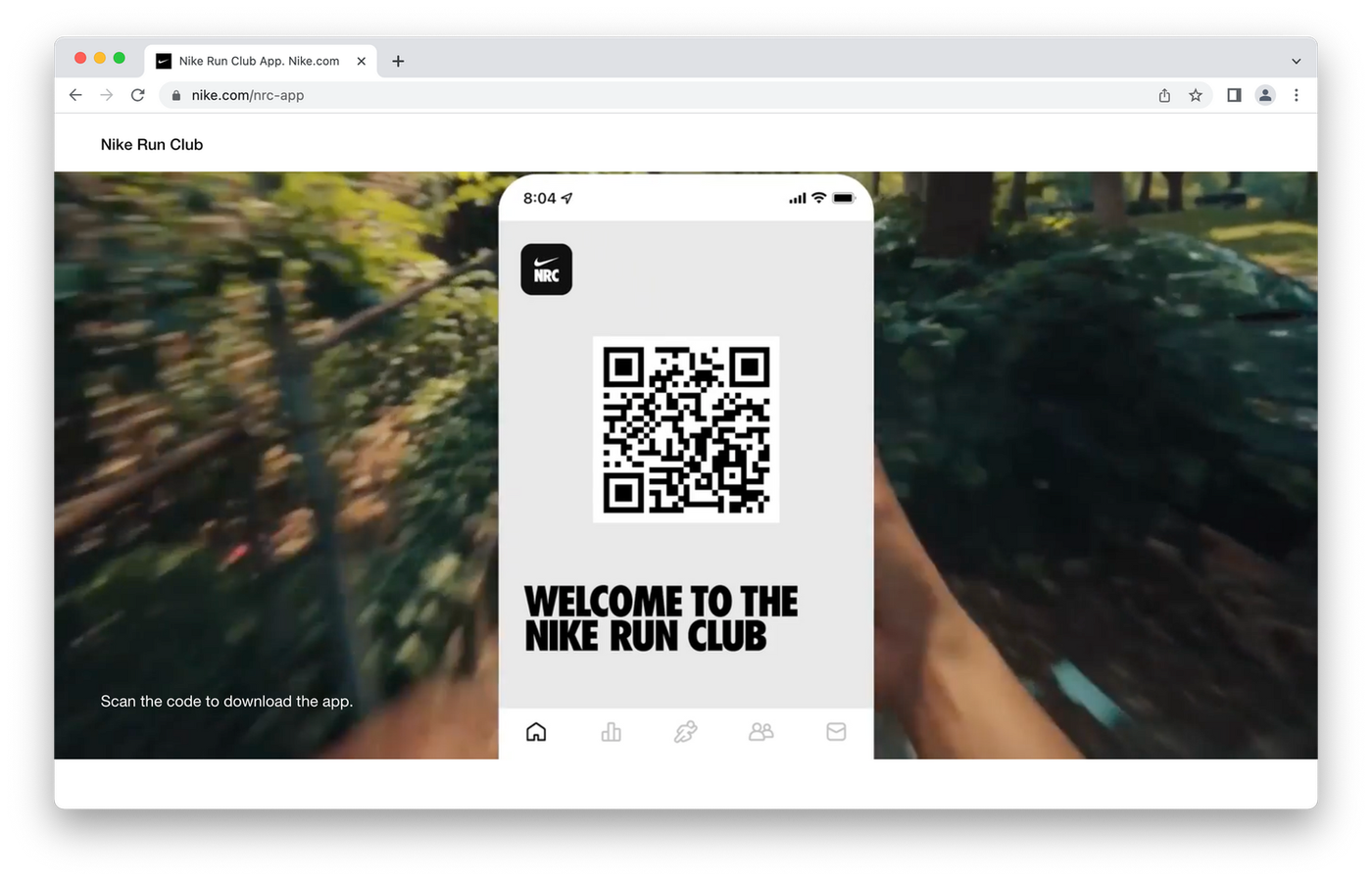 (Image Source: Nike Run Club)
(Image Source: Nike Run Club)“The Nike Run Club gives you the guidance, inspiration and innovation you need to become a better athlete. Join us to reach your goals and have fun along the way.”—via Nike website.
Run 5k? You get a special badge on Nike Run Club. Finish a hard workout? You get recognised on Nike Training Club. These mobile apps motivate folks to train, get fit and hit their exercise goals—and customers then link that success with Nike. Instant loyalty.
Use the way Nike has managed to marry a loyalty program with their product and brand as inspiration when choosing the type of program you want for your own business.
4. Use the right software
The days of punch cards are all but over. It’s all about mobile apps and loyalty points and making things as easy as possible for your customers to use and visualise their rewards.
Don’t worry. You don’t have to hire a web dev or build anything with HTML. There is a bunch of different customer loyalty software out there to help build and automate your loyalty program with minimal fuss.
The best part? Most tools provide all sorts of useful data about your audience, from demographics and interests to purchasing behaviour. It’s an absolute gold mine for market research.
Some of the biggest tools include:
- Giftbit
- Clover
- Thanx
- Smile.io
- Candybar
Candybar is one of the most cost-effective digital punch card programs you’ll find. It provides a digital “stamp” to customers who make a purchase. They can then track how close they are to getting rewards, or claim one with their next purchase.
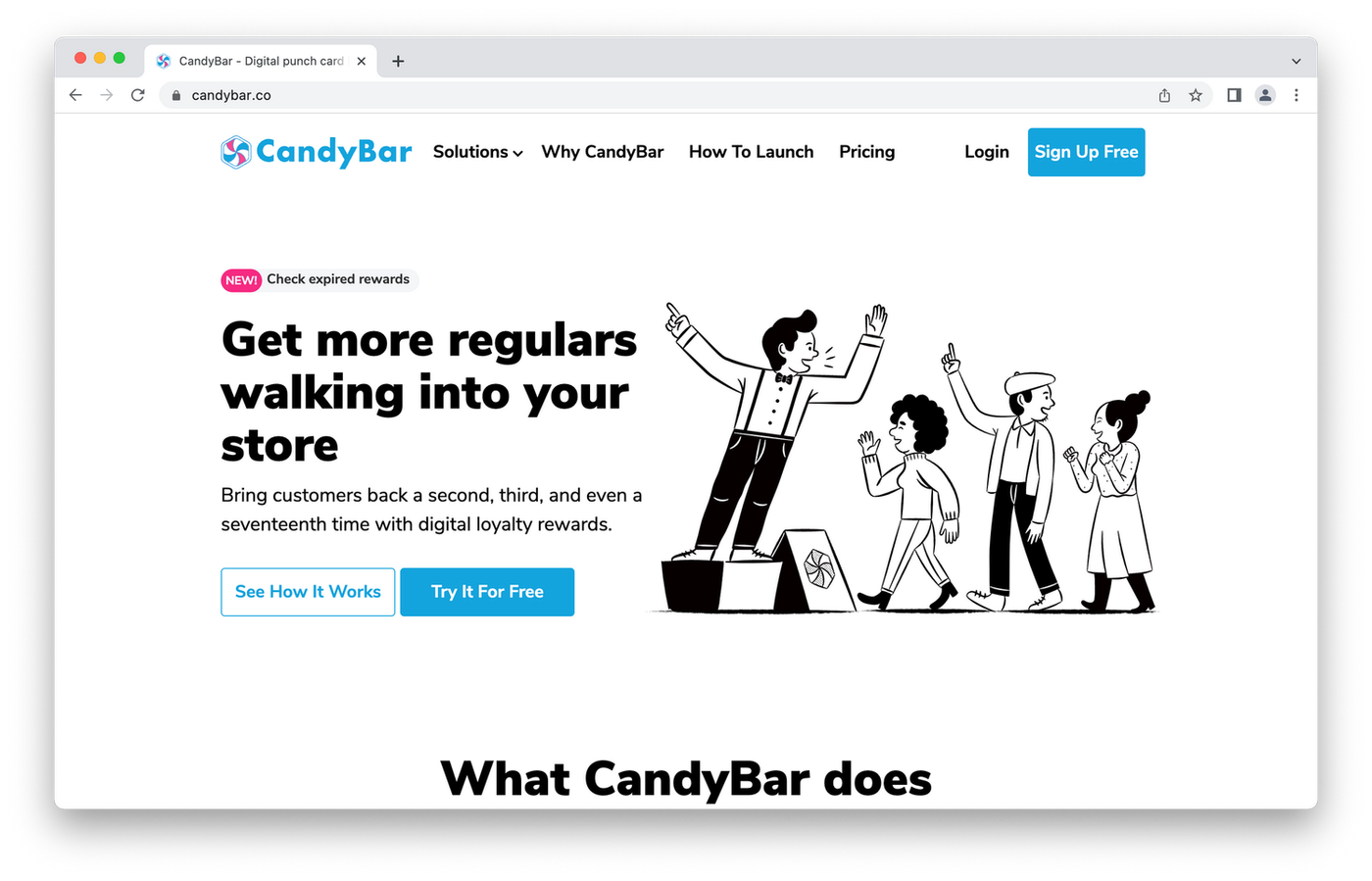 (Image Source: Candybar)
(Image Source: Candybar)The process is similar across each platform. Just sign up for an account, choose your rewards, set up your cashier page in your store and you’ll be ready to track your best customers and start handing out rewards.
5. Integrate it into your customer experience flow
You can’t just tack a rewards program on to an ecommerce store and hope for the best. That’s like buying a Blu Ray player and trying to use those red and yellow AV cords to watch movies in high definition.
It’s important to integrate it across your entire business — from your checkout to your marketing and any landing pages on your website. To get the most out of your rewards program you need to dive in with both feet.
Start with user testing to confirm whether it’s easy to use and navigate. This will also give you an idea whether customers are going to be receptive to the idea, or if it isn't a good fit for your business after all.
Assuming things go well, the next step is to train your sales and marketing team to navigate the program. You’ll want the Customer Success team to be able to answer any questions that might pop up, and the marketers to be able to sell it as part of a new marketing campaign.
6. Spread the word
Once your loyalty program is live you need to start collecting sign ups. That’s not possible unless folks know your fancy new loyalty program exists — so it’s time for your marketing team to shine and create some promo content.
Take advantage of all the usual channels you normally use to spread the word about new content, products or services. If you've got a brick and mortar store you should advertise in-store, and likewise, put a banner on your website to announce the new program to visitors.
Consider something like this page from Bokksu Rewards. They share a brief outline of the benefits of being a member, as well as a prominent CTA to create an account.
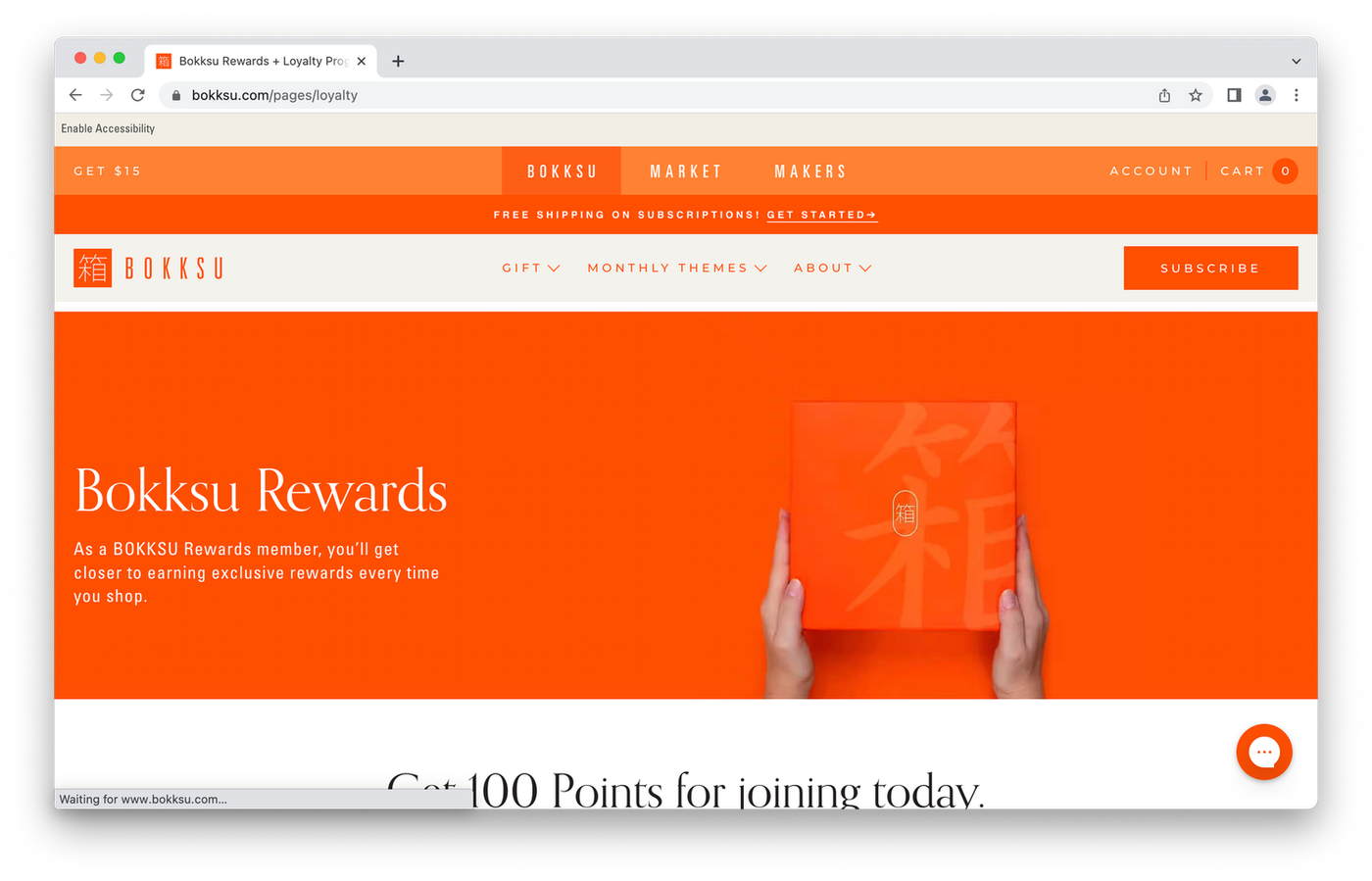 (Image Source: Bokksu)
(Image Source: Bokksu)Email and SMS marketing platforms are also super effective for loyalty program launches. It makes sense as most people are used to using their smartphones as virtual wallets and keeping loyalty cards on there.
Of course it goes without saying you should promote on social media. Create flashy posts with a tool like Canva and write engaging copy outlining the benefits and inviting folks to join.
Tips for building a successful customer rewards program
Any business can launch a customer rewards program. But you don’t just want to launch a rewards program, you want it to be successful. We’ve put together some extra tips to help put you on the path to success.
Offer a variety of rewards
Customers are understandably wary of loyalty programs. They worry that it’s just a money making scheme and a way to get them to spend more money (which they’re one hundred percent right about.)
To get around this hurdle you need to get customers excited about your program. And to do that, you need to have tempting incentives and a variety or rewards that add value to your customers’ lives.
Amazon Prime is a great example of this. What do online shoppers want? 1) Fast delivery and 2) cheap shipping. Amazon understands this, so to attract customers they offer free, expedited shipping.
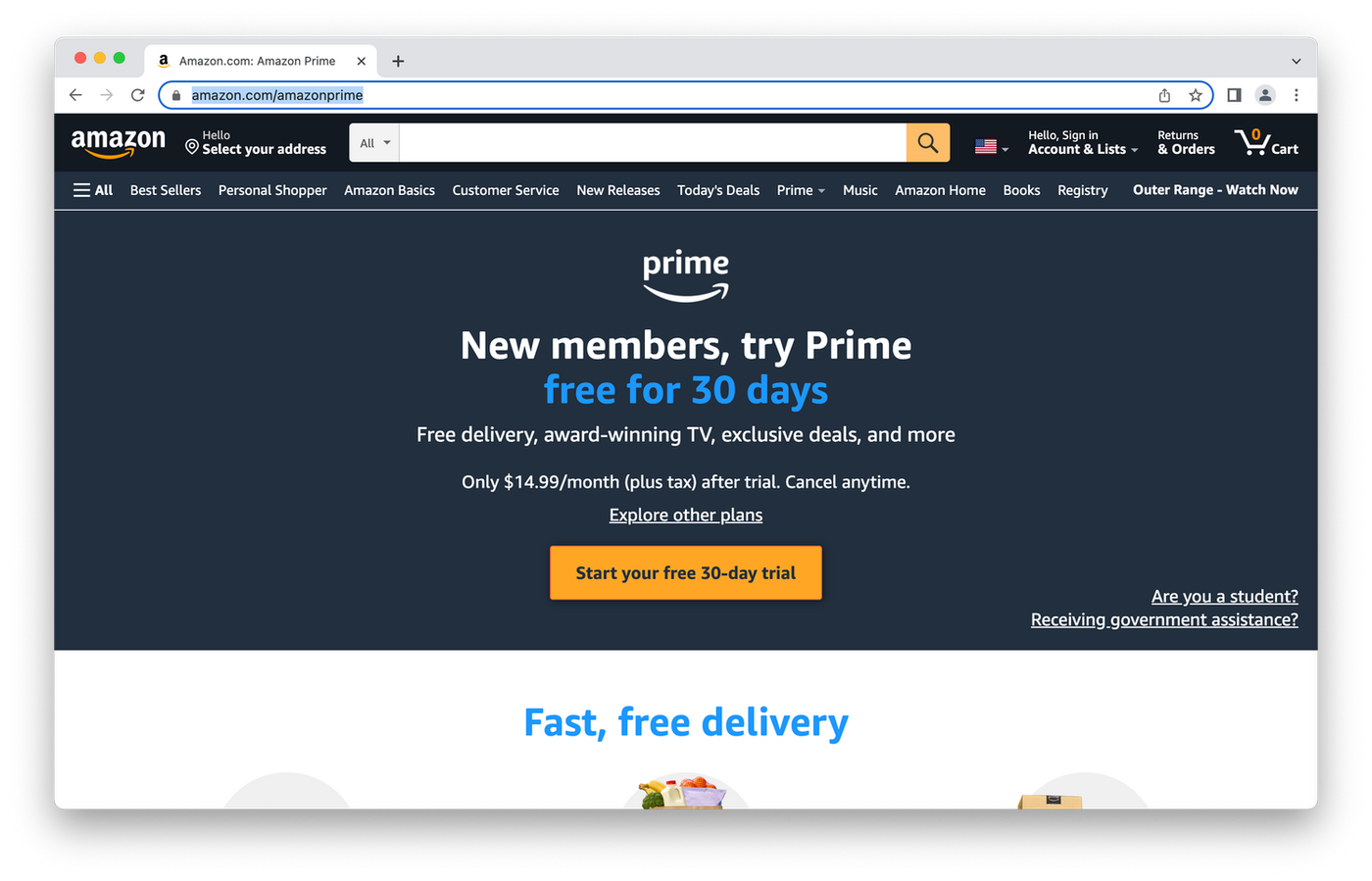 (Image Source: Amazon)
(Image Source: Amazon)But the perks don’t stop there. With Prime they also get access to media streaming services, discounts, and early access to deals. The free shipping opens the door and the additional benefits keep them signed up.
Think about what your customers want and figure out how to use that to draw them in to your rewards program. Then, offer a diverse selection of rewards to keep them engaged.
Tap into gamification 🎮
If you’ve ever played a video game of any kind, you’ll know that games are great at making us feel rewarded for completing tasks.
Using gamification you can tap into the similar strategies to reward customers and encourage them to complete tasks (like buying things and shopping in your store.) It’s a super effective technique that most huge brands have begun to adopt.
"Research conducted by Snipp found brands that incorporated gamification into their customer rewards programs saw a 47% rise in client engagement, a 22% rise in brand loyalty, and a 15% rise in brand awareness."
A great example of this is Starbucks. They gamify their rewards with a star system—every $1 you spend “earns” you two stars. Once you’ve “earned” 60 stars you can redeem them for a free drink.
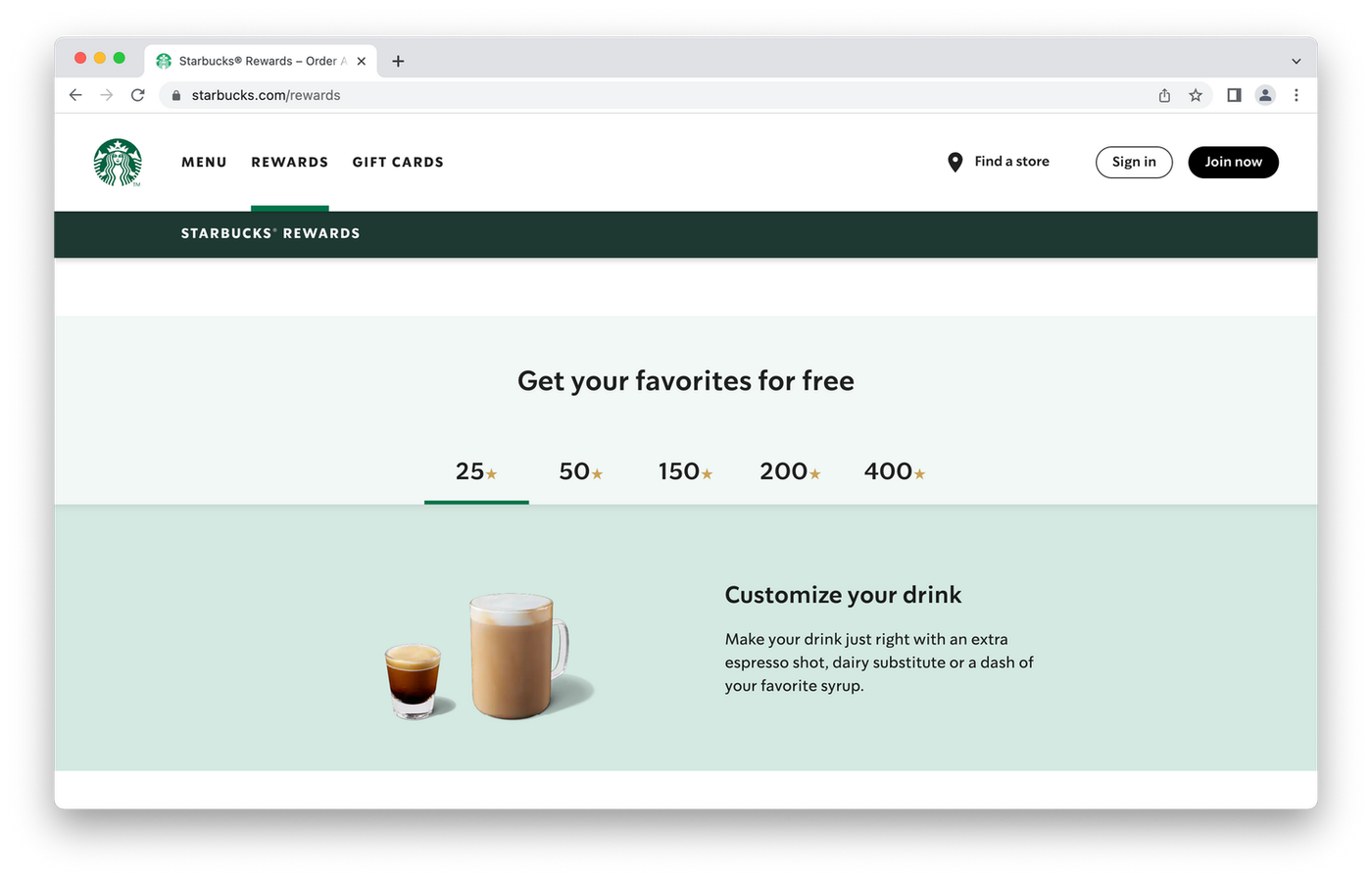 (Image Source: Starbucks)
(Image Source: Starbucks)By using gold stars and the term “earn”, Starbucks links spending money at their stores with achievement. Suddenly customers aren’t just buying a mocha frappe—they feel as if they’re being rewarded with each purchases.
Sounds simple, right? It is. But it works. Since adopting this gamified rewards program, membership has grown by 25% to 16.8 million active members in the U.S. alone. On top of that, 40% of all sales are attributed to their loyalty members.
Partner with other businesses
There’s only so much value an individual business can provide. So, why not take a leaf from The Avengers and team up with some other folks?
There are plenty of stores, online or brick and mortar, looking to attract customers. Partner with other businesses to increase the number of rewards you offer and cross-promote each other’s businesses as a byproduct.
Say you’re a personal trainer. You could partner with a local cafe to offer customers a free smoothie after a certain number of sessions. This would incentivise clients to book multiple sessions, reward them for hitting their goals, and benefit the cafe by bringing in new customers too.
For the best results, make sure you collaborate with businesses who aren’t direct competitors and only collaborate with brands that make sense for your demographic.
Make the benefits obvious
You want to make it as easy as possible for customers to visualise the benefits of being part of your loyalty program.
Amazon does a great job of this by showing customers how much more expensive and slow a delivery is without the benefits of Amazon Prime. It's a constant reminder of the value loyalty members receive with each purchase.
There are plenty of ways to do this without being too obtrusive. For an ecommerce store you might display the number of rewards points each product earns on your product pages, or in a brick and mortar store it could be as simple as a sign at your point of sale.
It comes down to trying to integrate your rewards program throughout your buying process and reminding customers of the value the program and (more importantly) your business, provides.
Form a better life now.
Measure results
Just like every marketing campaign, you’ve got to monitor the results of your loyalty program. That customer data gives precious insights in to the most valued segment of your audience.
And how else will you know whether your fancy new loyalty program works? Here are some of the metrics you should be tracking:
- Customer retention rate. How long a customer continues to purchase from your business.
- Customer churn rate. The rate at which customers shop at your store.
- Redemption rate. How often people redeem points on discounts or other rewards (calculated by dividing the points redeemed by the points issued.)
- Participation rate. The enrollment rate of your loyalty program (calculated by dividing the program members by your total number of customers.)
- Repeat purchase rate. The rate at which customers make repeat purchases to your store.
Over to you
Loyalty programs are an innovative way to build emotional connections between your business, your products and your audience.
When used effectively they boost customer satisfaction and loyalty, bring increased sales for your business, and help you build an audience that’s as loyal as a golden retriever (though not as cute, sorry.)
Why not start today? With Paperform you can set up website or embedded sign-up form for your rewards program today. Get started with a 7 day free trial — no credit card required.
This post was written by a guest author named Raul Galera, Chief Advocate at ReferralCandy.
Form a better life now.
Get your 7 day unrestricted trialHere is the ultimate list of online form builders, what they do best, their pricing, and examples to...
Independent retailers are some of the smartest operators in small business—but they’re forced to wor...
Independent retailers are some of the smartest operators in small business—but they’re forced to wor...
Looking for a worthy alternative to Zapier? In this guide, we've reviewed the best automation platfo...